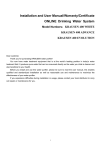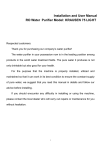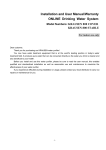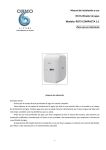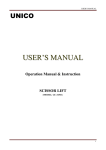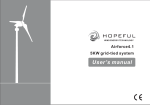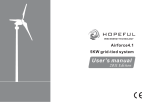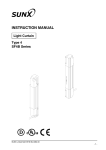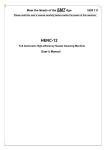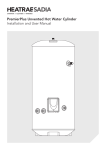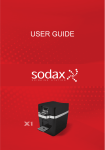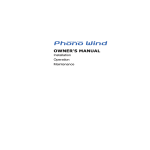Download Dear customer, Thank you for purchasing our company`s water
Transcript
Dear customer, Thank you for purchasing our company’s water purifier. You now have water treatment equipment that is at the world’s leading position in today’s water treatment field. It produces pure water that can be consumed directly so the water you drink is cleaner and also beneficial to your health. Before you install and use this water purifier, please be sure to read the user manual, this enables qualified and standardized installation as well as reasonable use and maintenance to maximize the effectiveness of your water purifier. If you experience difficulties during installation or usage, please contact your local distributor to carry out repairs or maintenance for you. 1 Contents Page Safety Considerations………………………………………………… 3 Product Introduction…………………………………………………… 5 Installation method ……………………………………………..………8 ◆ Pre-Installation Preparations………………………………………..…… 8 ◆ Instructions for Proper Installation……………………………….…….....8 ◆ Installation Notes……………………………………………...…..………11 Troubleshooting Methods…………………………………...………..12 Usage Methods…..…………………………………………………… 12 Maintenance and Upkeep……………………………………..………13 ◆ Filter Replacement Time……………………………….…………………13 ◆ Filter Replacement Method……………………………….………………14 ◆ Notes………..……………………………………………………………… 14 Failure Diagnosis and Resolution……………………….……………15 After-Sales Service……………………………………..………………16 Packing List……………………………………………………...………16 -2- Safety Considerations (Be sure to read and remember these safety considerations) In order to avoid harm to you and others or property damage, please make note of the following safety precautions. ★ Ignoring the following safety precautions could result in a risky situation: Warnings If you ignore contents in this section, it may cause permanent damage to the water purifier or cause serious property damage. Notes If you ignore the contents in this section, it may lead to damage of some parts of the water purifier or may result in some property damage. Warnings Do not disassemble or modify this water purifier on your own! Do not put things on the top of the machine! Unauthorized disassembly or Obstructing modification of the machine dissipation could machine damage or fires. lead to machine malfunctions or leakage the may heat lead to accidents. Please check with the store where you purchased this product for product consultation in order to arrange for repairs. Do not put heavy objects on the water purifier! Do not use this water purifier under high water pressure conditions! If heavy objects are placed on the Operating under high pressure water purifier, it may result in conditions may cause the water damage to the water purifier’s purifier outer resulting cover or internal pipes in to rupture, leakage, the components, which could lead to machine working improperly, or leakage, even serious property damage. the machine working improperly, or even serious property damage. Recommended inlet pressure is 0.1MPa to 0.35MPa. Do not let the machine come in contact with corrosive materials! Do not put the water purifier close to the fire! These materials could Do not put the water purifier near a corrode the outer cover and fire source or place where the affect the water parts or temperature is too high, this may some toxic and hazardous cause deformation or melting of compounds could penetrate the machine, causing damage or the water purifier pipes, leading to contaminated leakage, which could lead to water production and machine leakage, which could serious bodily and property damage. even cause bodily and property damage. -3- Do not use a power source exceeding the machine’s specified value, only use 220V AC power! When installing or repairing, the machine must be disconnected from the power source! The outlet used for the machine’s Otherwise it may lead to electric current must be greater than the shock. machine’s specified value; otherwise it may lead to overheating or fire. The machine must be connected to a reliable ground wire outlet and in accordance with relevant standards! Do not touch the power plug with wet hands! It may lead to electric shock. Failure to do that may result in electric shock. Notes Do not use the water purifier when the sewer is blocked up! The waste water discharge pipe and wastewater ratio device cannot be blocked! If it is used while the sewer is When the waste water discharge blocked, it may cause the pipes and waste water ratio device waste water to back up or are clogged, it may lead to high pollution to get inside the TDS effluent, the RO membrane water purifier. may get blocked or the water purifier may not work. Water purifier inlet water temperature should not exceed 38℃! Do not use in conditions under 5℃! If the temperature in the room is If the inlet water temperature below 5℃, please be sure to is over 38℃, it will damage take the freezing, such as starting the reverse membrane osmosis leading to membrane failure. measures to prevent heater or air conditioner to prevent leakage or cracked pipes caused from water freezing inside the machine. Do not use this water purifier outdoors! If this water purifier is used Do not use the water purifier in direct sunlight! outdoors, it can lead to When the water purifier is in accelerated the sunlight for a period of time, it and may create a breeding ground for cause microorganisms so the water aging water purifier parts, which of pipes can leaking or machine failure. purifier water quality will decrease, and they may pollute the internal components of the water purifier. -4- Product Introduction 1. Blown-up profile of the water purifier Diagram 1 2. Electrical Diagram Diagram 2. -5- 3. Water route map Diagram 3 4. Technical parameters Model CR500-A-S-1· Voltage AC 110-240V 50~60HZ Power Rating 120W Suitable Water Pressure 0.1MPa-0.35MPa Operating Pressure 0.5MPa-0.7MPa Inlet Water Temperature 5-38℃ Maximum Inlet Water TDS Value ≤1000PPM Maximum Daily Water Production Volume 500 Gallons, approximately 1892 Liters Standard No. Q/SXZZ 13-2010 Electric Shock Protection Type Type II Suitable Water Quality Municipal tap water meeting GB5749-2006 standards the Note: Due to product improvements, the above parameters may change, but the product nameplate shall stay the same. TDS refers to the influent total dissolved solids. 5. Water Purifier Main Parts Function Introduction Using the current most advanced international RO technology, standard configuration is as follows: (1)First stage: 10-inch 5-micron PP filter PP filter with a 5 micron pore size can effectively filter rust, sand, and other solid impurities and larger particles in water. -6- (2)Second stage: granular activated carbon filter Can effectively adsorb free chlorine, humus, disinfection byproducts, smells, discoloration, and other substances in water. (3)Third stage:1-micron PP filter or CTO filter Can further remove particles of a smaller size, such as suspended solids and colloids. (4)Fourth stage: side stream reverse osmosis membrane Pore size of 0.0001 microns (0.1nm), reduces bacteria by 4,000 times, reduces infectious viruses by more than 200 times, therefore it can effectively remove bacteria, viruses, heavy metals, pesticide residues, and other harmful substances. (5)Fifth stage: granular activated carbon post-filter Removes odor and adjusts taste. Note: Due to technical improvements, the above 5 stage filters may change, please take practicality as standard. 6. Function Introduction of Accessory (1 ) High Pressure Pump:Boosts pressure to create a stable working environment for the RO membrane. ( 2 ) Low Pressure Switch:To prevent pump idling. When the inlet water pressure is less than 0.03MPa or when the inlet water stops, the low-voltage switch automatically shuts off the power source so the machine stops. ( 3 ) High Pressure Switch: To prevent pump rotating full. It automatically shuts off the power source so the machine stops when pressure of pure water attains rated one. ( 4 ) Inlet Water Solenoid Valve: Connects or cuts off incoming water. Operating pressure range is less than ≤0.6MPa. ( 5 ) No Return Valve: Also known as a one-way valve, control the flow direction. ( 6 ) Auto Flush Solenoid Valve: Automatically flushes the reverse osmosis membrane. ( 7 )Electric Adaptor: Converts 110-220V AC to 36V DC (the machine’s safe operating voltage). 7. Specifications (1) Without tank: Completely advanced design, big flow volume, directly drink when open machine, safe and healthy. (2) Big flow volume: About 1.3L per minute(25℃). (3) Low-pressure start: Low water pressure starts, only requires 0.03MPa. (4) MLSB membrane element production technology: Makes the membrane utilization rate reach world leading levels, increases water production volume, reduces wastewater emissions. (5) Anti-Pollution Low Pressure RO Membrane: Without flushing design, save water and power; Without storage water tank, ration between pure water and waste water is 1:1; Waste water volume is only 60% of traditional machine. (6)New Generation big flow booster pump: Low noise, high efficiency, the flow and pressure are 20% more than 300GPDbooster pump. (7)Auto Flush Function: The system can automatically control the water auto flush process for the RO membrane to ensure more reliable and safe operation of this machine. -7- (8)With Water Pressure Gauge. Installation Method This company recommends that professionals install the machine for you because you must use drills and other power tools in the process. If you are installing it yourself, please refer to the following steps and diagrams: 1. Pre-Installation Preparations ① Confirm the location the water purifier will be installed (when installing, it should depend on the actual circumstances) ② Confirm that you have the various tools required for installation. Adjustable spanner 1 Drill 1 6.2mm drill bit 1 (wastewater hole) Hole saw, φ14mm 1 (high-speed steel or marble hole saw) Phillips and flathead screwdrivers 1 of each Scissors 1 pair 14-16mm wrench 1 19-21mm wrench 1 Needle nose pliers 1 ③ Confirm that you have all of the accessories required for installation ④ Prior to installation, turn off the water and/or electricity 2. Instructions for Proper Installation ① Inlet water metal hose and 3-way inlet water joint installation method (if the metal hose diameter is 9mm, the 3-way inlet water joint must be purchased separately) Before installing, close the inlet water valve. Unscrew the inlet water valve from the metal hose. Remove the inlet water three-way joint from the water purifier accessories box. Thread one end of the inlet water three-way joint into the inlet water valve outlet connection. One end of the metal hose should be connected to the external threads of the inlet water three-way joint (see diagram 4). -8- Diagram 4 ② Inlet water 3-way joint and inlet water ball valve installation method Take out the inlet water ball valve from the water purifier accessory box. Wrap one end of the ball valve with the appropriate Teflon tape (see diagram 5). Then screw the ball valve into the corresponding hole of the inlet water 3-way joint (see diagram 6). Take the 6mm hose from the accessories box. Using scissors cut a suitable length of hose. Connect one end of the hose with the inlet water ball valve (see diagram 4). Then screw the metal nut in place. The other end of the hose should be connected to the first filter inlet water connection on the water purifier. (Note: The pipe should be firmly in place, otherwise leakage could occur). Diagram 5 Diagram 6 ③ Gooseneck faucet installation In the counter where the faucet is to be installed, drill a φ14mm hole in an appropriate position. Then take out the faucet from the water purifier accessories box. Start the faucet installation: First put the stainless steel neck on the faucet main body (see diagram 7), then lower the main part of the faucet into the already drilled hole and screw the fixed nut into the bottom end of the faucet to fix the faucet to the counter. Finally, put the appropriate length of 6mm pipe into the inlet water connection, put the 6mm pipe stopper into one end, put on the 6mm nut, and screw to the bottom of the faucet (see diagram 7). If you want to fix the faucet to the wall, please use the faucet hanging piece. (When installing, be sure to tighten the joints to prevent leakage.) -9- Stainless steel faucet Main part of faucet Inlet water connection Diagram 7 Diagram 8 ④ Wastewater pipe installation Using a drill, make a φ6.2mm hole into the sink pipe drain. Take out an appropriate length of the 6mm pipe. One end should be inserted into the small hole (see diagram 8). Put some silica gel where the 6mm pipe and the drain pipe connect to prevent leakage. Then, using a cable tie, fix the wastewater pipe to the drain pipe. ⑤ Side stream RO membrane installation method Take the water purifier out of the package carton. Open the machine cover. Unscrew the nut of the membrane housing cap to remove the inlet housing pipe. Open the housing cap by membrane housing wrench. Check if the vacuum packing of RO membrane is leaking. If not, take the membrane from its packaging. Make sure there are 4 “O” rings in one end of the membrane central tube and 2 “O” rings in the other end. Check whether there are expansion and deformation “O” rings, if not, insert the 4 “O” rings end into the membrane housing tightly(See Diagram 9), finally , screw the housing cap, take membrane housing wrench to tighten the cap. Insert the inlet pipe to the housing cap, screw the nut. Put the housing into the single clip and close the machine cover. Warnings: ◆ When installing the RO membrane you should pay attention to the direction of the membrane; ◆ When installing the RO membrane, Make sure there are 4 “O” rings in one end of the membrane central tube and 2 “O” rings in the other end. Check whether there are expansion and deformation “O” rings ◆ When installing, be sure to insert the end with 4 O-rings into the membrane housing. Be sure when installing to only use a little force to put the RO membrane into the membrane housing. If you encounter too much resistance, please do not force the reverse osmosis membrane into the membrane housing, doing so may cause permanent damage to the membrane housing or membrane components (the manufacturer does not assume responsibility for returned components due to damage during installation); ◆ Damage to the membrane housing and reverse osmosis membrane element caused as a result of the above reasons is not covered under the water purifier warranty. -10- Diagram 9 ⑥ Pre-filter installation First take the pre-filter out of the packaging, tear off the packaging of the filters in the order they should be inserted, first is the 5 micron PP filter; second is the granular activated carbon filter, note that the rubber pad must be installed on the top of the activated carbon filter; third is the 1 micron PP filter (See Diagram 10). Diagram 10 3. Installation Notes ① When installing the water pipes, a drain stopper should not be installed. In addition, for the water pipe bottom connector, the screw nut should have no wire teeth exposed. ② If the inlet water pipe is 9mm, ensure that the inlet water pipe and connector have 30-40cm of straight piping to avoid burst pipe accidents caused by bending in the pipe. ③ If the power cord wiring needs to be longer, then according to the wiring requirements use a Φ8mm pinched tube to wrap around the connection. Then, wrap insulating electrical tape around the outside. Do not place it on the floor; it should be suspended in the air or in another place away from the ground. ④ When installing, if you need to make a hole in the wall, first make sure that there are no electricity or water lines in the location you plan to drill. Troubleshooting Methods -11- After confirming that the water route connections are correct, confirm that you have a power supply and/or a water supply. Then follow these steps to troubleshoot the machine: Diagram 11 1. Open the tap water inlet water ball valve as well as the water purifier inlet water ball valve, plug in the power (see diagram 11), wait for the filters to fill up water, water will start flowing from the gooseneck faucet. 2. Wait for the main machine to operate stably (about 5-10 minutes), check each of the connections on the main machine to make sure they are secure, see if there is any leakage from the membrane shell, filter cartridges, etc. 3. Turn off the gooseneck faucet, wait for approximately 30 seconds. Check whether the waste water on the water purifier has stopped. 4. Turn on the gooseneck faucet, observe whether water begins to flow, if there is no water, check whether it is because the tap water pressure is too low or the high-pressure switch cannot reset. 5. When the machine is in operating condition, close the inlet water ball valve, after a short time observe whether the machine has stopped operating. If it has not stopped, check whether the low-pressure switch cannot reset. 6. Wait some time to ensure everything is operating normally. Then the water purifier can be used safely. Usage Methods 1. The major components of this machine are plastic. When using the product always observe the integrity of the water purifier to ensure safe use. 2. In order to prevent microbial contamination of membrane components during storage and transportation, the reverse osmosis membrane element package contains a small amount of protective solution, while the activated carbon post-filter will emit activated carbon powder the first time it is used. So pure water produced in the first hour should be emitted; otherwise the output water taste may be unusual. 3. When you start operating the purifier, the output water TDS value may be a little high. After running the machine for some time, the TDS value for the output water will gradually decrease until it is stable. 4. When you are using the water purifier, the switch on the inlet water ball valve should be opened. You need to turn on the faucet to get drinking water. When water is not needed the faucet should be turned off. The water purifier high-pressure switch will automatically shut off the water. 5. The machine should be used at least twice of every week in order to avoid the pure water’s microorganism pollution for long no use. 6. In these “usage methods”, “usage” refers to when the power supply is connected and/or the inlet water ball valve is open so the water purifier is in a working condition. -12- Maintenance and Upkeep 1. Flushing the RO Membrane As water passes through the RO membrane, impurities and bacteria are retained on the membrane surface, so you should regularly flush the machine to ensure that the RO membrane performance can achieve the best results. When the machine is turned on for each time, it will automatically flush the membrane for 18 seconds. 2. Filter Replacement Time 1. This machine’s filter replacement cycle for the various filters is derived from statistical indicators on average tap water use estimates. If there are big discrepancies between the user’s actual water quality and utilization rate and the average indicators, there will be more obvious differences between the filter’s actual use time and the estimated cycle such as premature filter clogging, premature failure, etc. If this happens, filter replacement should be based on actual use, you should also promptly contact your local after-sales service department. 2. This machine’s estimated filter replacement cycle is based on average household water consumption and is suitable only for residential use, do not install this machine in places that require large volumes of water. If the water volume requirements are large, this company has appropriate machines for business purchase. 3. According to economic statistics on municipal tap water, a three person family on average uses 10L of water a day, according to the water volume and inlet water quality conditions, overall filter volume is approximately as follows (the following data is for reference only): Progression Water Volume (tons) First: 10-inch 5-micron PP filter 7.5 Second: 10-inch 85C granular activated carbon filter 7.5 Third: 10-inch 1-micron PP filter 10 Fifth: Post-activated carbon filter 6 Note: It is recommended that filter element replacement is carried out by after-sales staff. Water quality has a great influence on the life of the filter, the RO membrane’s lifespan is affected by many factors, the above table expresses lifespan under standard conditions, in actual usage, because the water quality may be different, the lifespan may exceed the above estimate, it may also be lower than the estimate, this data is for reference only. Under normal circumstances if the following situations are experienced, you should consider replacing the filter: ◆ Poor water quality, taste declines, TDS value of water rises; ◆ Water flow is significantly reduced, check to see if the filter or membrane is blocked (and determine that it was not caused by a temperature drop); ◆ If the filter’s outer surface is covered in mud or the filter has significantly changed color; ◆ If serious filter clogging leads to no pure water from the water purifier. 3. Filter Replacement Method 1. Replacing the 1st and 3rd stage PP filters First close the inlet water ball valve, using the filter cartridge wrench unscrew the 1st and 3rd stage filter cartridges, remove the old filters, then take the new filters out of the packaging, finally place the filters in the filter cartridges (Note: place the 5 micron PP filter in the 1st stage filter cartridge, the -13- 1 micron PP filter in the 3rd stage filter cartridge), using the filter wrench, tighten the filter cover. 2. Replacing the 2nd stage granular activated carbon filter First close the inlet water ball valve, using the filter cartridge wrench unscrew the 2nd stage filter, remove the old filter, then take the new filter out of its packaging (the rubber pad on the filter does not need to be taken off), finally place the filter inside the filter cartridge (note: the direction of the granular activated carbon filter should be with the rubber pad end up towards the filter covers), use the wrench to tighten the filter cover. 3. For replacement of membrane elements please see “RO Membrane Installation” (Page 10). 4. Notes (1) Notes before filter use: When replacing the granular activated carbon filter, first flush the machine in order to avoid activated carbon powder from the granular activated carbon filter from flowing into the third stage filter or even the RO membrane, resulting in filter and membrane component damage. Do the following: 1. Turn off the water purifier inlet water valve; 2. Using the filter cartridge wrench, remove the water purifier’s third stage filter; 3. Place a large container near the third filter cartridge cover to collect the black water; 4. Open the inlet water valve, wait until the water is no longer black; 5. Close the inlet water valve, reinsert the third stage filter into the filter cartridge, and screw it in tight. For the post-activated carbon filter please flush for 1-2 minutes before using. (2) Other considerations: 1. RO membrane water production volume The RO membrane component water volume is influenced by the inlet water pressure and water temperature, this machine’s stated volume of 500GPD is tested with net pressure of 0.5MPa and inlet water temperature of 25℃, if the net pressure is less than 0.5MPa or if the inlet water temperature is less than 25℃, the RO membrane element water production will be less than 500GPD. 2. Disposal of old filters After replacing old filters, they cannot be cleaned and reused; it is recommended that you dispose of them with solid waste garbage. Notes ★ When any of the following situations occur, immediately disconnect the water purifier water source (close the inlet water ball valve) and/or the power source and carry out repairs. · If the water purifier pipes or related components are leaking. · If the water purifier’s related components stop working. · If any components leak electricity. · If there are any other anomalies or failures. ★ When you go out or do not use the machine, disconnect the water purifier water source (close the inlet water ball valve) and/or power source. ★ If the water purifier parts are damaged, it is recommended that the water purifier be entrusted to the manufacturer or distributor, service center, or specialized technical personnel for replacement to prevent loss caused by improper operation, the manufacturer is not liable for losses caused by operation or use not in accordance with the instructions and reminders. -14- Failure Diagnosis and Resolution Failure Experienced Reason Resolution Method The power source is not connected Check the power source or power source plug Low water pressure or no water Check the water pressure Low-pressure switch failure, cannot connect the power source After connecting the water source, measure the resistance, replace High-pressure switch cannot reset After letting off the pressure, measure the resistance, replace The transformer is burned out Measure the output voltage, replace High-pressure pump has lost pressure Measure the water pump pressure, replace Inlet water solenoid valve will not let water in (no outlet water or wastewater) Replace the inlet water solenoid valve A pre-filter is blocked Observe the output water and wastewater, replace the pre-filter The non return valve is blocked (wastewater, no output water) Replace the non return valve The RO membrane is blocked Clean or replace the RO membrane The machine is turned off but wastewater has not stopped Inlet water solenoid valve failed, cannot effectively cut off the water supply Observe the wastewater, replace the inlet water solenoid valve The non return valve has lost pressure (wastewater flow rate is low) Observe the wastewater, replace the non return valve After the machine is filled with water, it starts repeatedly The non return valve has lost pressure Replace the non return valve High-pressure switch failure Replace the high-pressure switch The system exhibits a loss of pressure After checking the non return valve, check whether there is water leakage in the pipes A pre-filter is blocked Replace the pre-filter The RO membrane is blocked Clean or replace the RO membrane Inlet water solenoid valve failure Replace the inlet water solenoid valve Non return valve is blocked Replace the non return valve High-pressure pump pressure is not sufficient Check the high-pressure pump output water pressure, replace The machine will not start The high-pressure pump is working properly, but no water is being produced The output water flow is low or no water is flowing After-Sales Service 1. Warranty period: One-year machine warranty. The warranty does not include consumables (consumables include filters, RO membranes). -15- 2. Please keep the warranty in a safe place. For maintenance you must have your purchase invoice, only then is the warranty effective. 3. The following situations do not fall under the scope of the warranty: no invoice, an altered machine number, the user replacing parts or modifying the water purifier on their own, the user not following the requirements of the user manual, and man-made damage. 4. If your water purifier exhibits abnormal behavior, please immediately turn off the water source, cut the power, and contact your local vendor. Notes: The company reserves the right to change product design, configuration, and specifications without notice. The company has final explanation rights if this manual is unclear, has mistakes, or if there are printing issues which cause problems. Packing List · Main machine (including reverse osmosis membrane) 1 unit · 1/4’’ water pipe 1 roll · 3/8’’ Water pipe 1 roll · Installation manual, certificate, warranty 1 of each · Gooseneck faucet 1 · Filter cartridge wrench 1 · Membrane shell wrench 1 · Accessories bag Contents: Inlet water 3-way connector Inlet water ball valve Pipe plug Screw nut Faucet hanging piece 1 bag 1 1 2 1 1 Notes: 0.1MPa =1.02Kg/cm2=14.5Psi 1Psi=0.07Kg/cm2 1 Gallon=3.785 Liters 500GPD=500 Gallons/Day=1892 Liters/day=1314 Milliliters/minute -16-

















